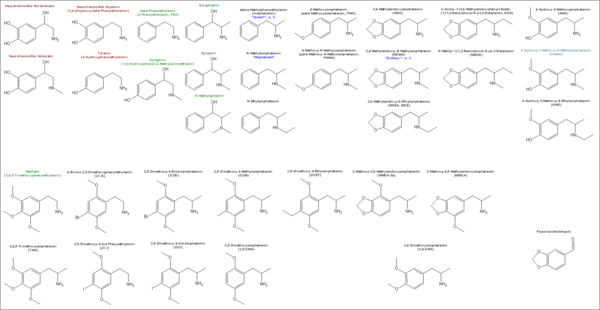- Phenylalkylamin
-
Phenylalkylamine sind chemische Verbindungen, die vom Phenylethylamin abgeleitet sind. Zahlreiche β-Phenylalkylamine besitzen eine weite Verbreitung in der Natur (z. B. Tyramin und Dopamin), während andere künstlichen Ursprungs sind (z. B. Amphetamine). Natürlich vorkommende Phenylalkylamine besitzen beispielsweise als L-Aminosäuren (L-Tyrosin und L-Phenylalanin) eine grundlegende Bedeutung für das Leben. Im menschlichen und tierischen Organismus spielen Phenylalkylamine darüber hinaus eine wichtige Rolle als Neurotransmitter (z. B. Dopamin) und Hormone (z. B. Adrenalin). Viele im Pflanzenreich vorkommende Alkaloide sind ebenfalls den Phenylalkylamine zuzuordnen (z. B. Ephedrin, Mescalin). Synthetisch hergestellte Phenylethylamine, wie z. B. Verapamil, finden als Arzneimittel Anwendung. Zahlreiche Verbindungen dieser Stoffgruppe, insbesondere die Amphetamine, besitzen psychotrope Eigenschaften.
Inhaltsverzeichnis
Phenylethylamine
- Phenethylamin (PEA) #142
- 4-Hydroxyphenylethylamin (Tyramin)
- 1-(3-Hydroxyphenyl)-2-(ethylamino)ethanol (Etilefrin)
- 1-(4-Hydroxyphenyl)-2-(methylamino)ethanol (Synephrin)
- Katecholamine
- Adrenalin
- Noradrenalin
- Dopamin (3,4-Dihydroxy-β-phenylethylamin)
- Isoprenalin
- Orciprenalin
- Dobutamin
- Reproterol
- Terbutalin
- Dimethoxyphenylethylamine
- Venlafaxin
- 4-Brom-2,5-dimethoxyphenylethylamin (2C-B) #20
- 4-Chlor-2,5-dimethoxyphenylethylamin (2C-C) #22, 2C-C
- 4-Iod-2,5-dimethoxyphenylethylamin (2C-I) #33, 2C-I
- 2,5-Dimethoxy-4-methylphenylethylamin (2C-D) #23
- 2,5-Dimethoxy-4-ethylphenylethylamin (2C-E) #24, 2C-E
- 2,5-Dimethoxy-4-ethylthiophenylethylamin (2C-T-2) #40, 2C-T-2
- 2,5-Dimethoxy-4-(iso)-propylthiophenylethylamin (2C-T-4) #41
- 2,5-Dimethoxy-4-(n)-propylthiophenylethylamin (2C-T-7) #43, 2C-T-7
- 2,5-Dimethoxy-4-cyclopropylmethylthiophenylethylamin (2C-T-8) #44
- 2,5-Dimethoxy-4-butylthiophenylethylamin (2C-T-9) #45, 2C-T-9
- 2,5-Dimethoxy-4-(2-fluorethylthio)phenylethylamin (2C-T-21) #49
- Trimethoxyphenylethylamine
- 3,4,5-Trimethoxyphenylethylamin (Meskalin, M) #96, Meskalin
- 2,3,4-Trimethoxyphenylethylamin (IM) #91
- 2,4,5-Trimethoxyphenylethylamin (TMPEA) #168
Amphetamine
(Trivialbezeichnung für 1-Phenyl-2-aminopropane)
- Ephedrin
- Norephedrin / Cathin
- N-Methylephedrin
- Amphetamin
- N-Methylamphetamin
- N-Ethylamphetamin
- 4-Methoxyamphetamin (PMA) #97
- 4-Methoxy-N-methylamphetamin (PMMA, Methyl-MA) #130
- Dimethoxyamphetamine
- Methylendioxyamphetamine
- 3,4-Methylendioxyamphetamin (MDA) #100, MDA
- 3,4-Methylendioxy-N-methylamphetamin (MDMA) #109, MDMA
- 3,4-Methylendioxy-N-ethylamphetamin (MDEA) #106, MDE (MDEA)
- 2-Methoxy-3,4-methylendioxyamphetamin (MMDA-3a) #134, MMDA-3a
- 3-Methoxy-4,5-methylendioxyamphetamin (MMDA) #132, MMDA
- Trimethoxy- und Trialkoxyamphetamine
- 3,4,5-Trimethoxyamphetamin (TMA) #157, TMA
- 2,4,5-Trimethoxyamphetamin (TMA-2) #158, TMA-2
- 2,3,4-Trimethoxyamphetamin (TMA-3) #159
- 2,3,5-Trimethoxyamphetamin (TMA-4) #160, TMA-4
- 2,3,6-Trimethoxyamphetamin (TMA-5) #161, TMA-5
- 2,4,6-Trimethoxyamphetamin (TMA-6) #162, TMA-6
1-Phenyl-2-aminobutane
- 2-N-Methylamino-1-(3,4-methylendioxyphenyl)butan (MBDB) #128
- 2-Amino-1-(3,4-methylendioxyphenyl)butan (BDB) #94
Übersicht
Grafische Übersicht
Übersicht über eine kleine Auswahl an endogenen, natürlichen und synthetischen Phenylalkylaminen, inklusive einiger Ausgangs- und Abbaustoffe
Siehe auch
Weblinks
- PIHKAL online – via erowid (englisch)
- Substituenten-Tabelle (englisch)
- Darstellungsmethoden (Dissertation, pdf)
Wikimedia Foundation.


